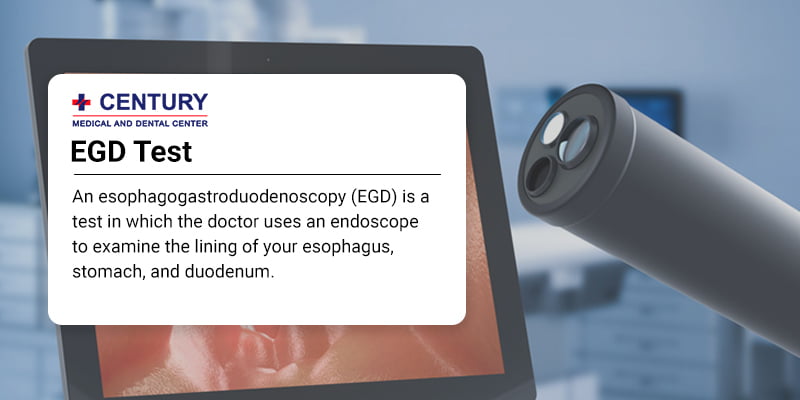If you experience symptoms associated with the upper GI tract, or unexplained stomach pain and eating problems, EGD can diagnose your condition and find the root cause of your discomfort. Schedule an appointment with the experienced and board-certified gastroenterologists at the Century Medical and Dental Center to learn more about upper endoscopy and what conditions it can help detect and treat. Digestive problems affect your life and health significantly, and you can end up with complications if you do not seek medical assistance timely. The top-rated specialists can help you find relief from all types of digestive disorders by performing the best endoscopic procedure to identify the cause of your discomfort.
Doctors recommend EGD if you have persistent stomach ache along with other troubling symptoms that begin to affect your eating habits and routine life.
Occasional stomach ache is normal, and it could be anything from getting hit by a stomach bug to something that did not go well with you or even a food allergy, but anything serious than that requires detailed investigation. Your gastroenterologist may be able to pinpoint the cause of your stomach problems by performing an upper GI endoscopy.
An esophagogastroduodenoscopy (EGD) is a test in which the doctor uses an endoscope to examine the lining of your esophagus, stomach, and duodenum.
The endoscope is a long, thin, flexible tube with a light, and camera attached to the end. An EGD test involves a procedure in which an endoscope is passed down the throat, along the length of your esophagus. It checks any problems that you may be having, related to the stomach, esophagus, and duodenum. EGD is used for both diagnostic procedures and therapeutic procedures.
Usually performed as an outpatient procedure, upper endoscopy is sometimes conducted in the hospital or emergency room to identify and treat conditions like upper digestive system bleeding.

Popularly known as EGD, this test uses an endoscope to take pictures of the esophagus, stomach, and duodenum to diagnose any problems in the upper gastrointestinal (GI) tract.
The doctor will begin the procedure by sedating you. While you are under sedation, the doctor will insert the tube into the GI tract through your mouth. The scope is then gently pushed along the GI tract, allowing it to take video images that the doctor can see on a monitor.
Your gastroenterologist may suggest EGD if you suffer from the following symptoms:
In some cases, your doctor may recommend EGD to check how effectively a treatment is progressing or to track complications if you suffer from:
EGD plays a key role in diagnosing the following conditions:
Endoscopy can also identify inflammation, ulcers, and tumors. Doctors prefer upper endoscopy as it is more accurate than x-rays for detecting abnormal growths such as cancer and for examining the inside of the upper digestive system.
Contrary to what many people believe, an EGD is not only helpful in diagnosing problems in the upper GI tract. The gastroenterologist can also attach specialized tools to the scope to look up and even repair minor issues, including:
Controlling upper GI bleeding
EGD is the best option when it comes to diagnosing upper GI problems. The procedure has the following benefits:
A relatively low-risk procedure, an EGD makes it easy for the physicians to find the cause of specific digestive tract problems without making you feel a thing. It may irritate the throat or cause some bloating, but that goes away without causing any harm or lasting symptoms.
At times doctors combine an upper endoscopy with the following procedures:
With endoscopic treatment tools, healthcare providers can now offer better quality care to the patients and provide quick and effective treatment of various upper and lower digestive tracts.
Most of us do not think about seeking medical assistance for our gastric troubles unless they turn severe and lead to inflammation, persistent stomach ache, severe heartburn, and inability to eat or digest properly. The highly trained and experienced gastroenterologists at the
Century Medical and Dental Center provide the best solutions to all the problems related to the upper GI tract and treat everything from acid reflux to color cancer. The specialist doctors use EGD, the most reliable test to diagnose the unpleasant symptoms you are experiencing and help you live a better quality of life and enjoy the foods you love. With a detailed look at your esophagus, stomach, and duodenum, the physicians can pinpoint the exact cause of your discomfort and suggest treatments that get you on the road to a speedy recovery.
Century Medical and Dental Center is an accredited healthcare facility in NY that operates in accordance with Article 28, a public health law. This law regulates and recognizes accreditation for public healthcare facilities, ensuring they are licensed and operated correctly. By undergoing the Article 28 process and achieving accreditation, Century Medical and Dental Center demonstrates its commitment to meeting the highest standards of care.
As a multidisciplinary medical center, we have highly qualified doctors, nurses, and support staff who are working hard to provide the best medical care to patients in Manhattan, NY, Brooklyn, NY, and Bronx, NY including Brooklyn Heights, Dumbo, Prospect Heights, Park Slope, Clinton Hill, Boerum Hill, Red Hook, Harlem, Gravesneck, Flatbush, and Bedford-Stuyvesant.